‘It absolutely hurts:’ Oakland fans lament possible loss of the A’s to Las Vegas
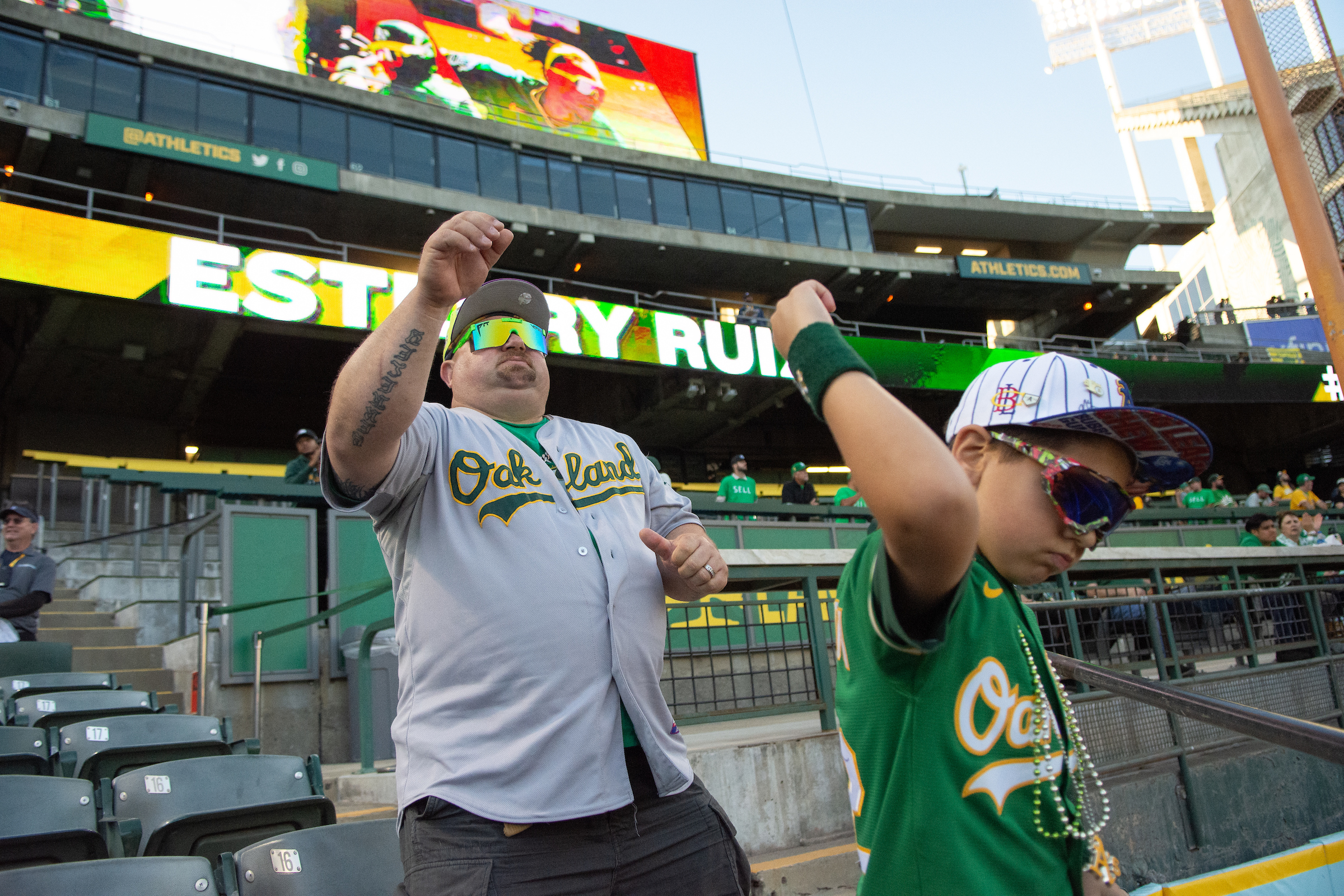
Editor’s Note: This story is the first of a two-part series on the potential move of the Oakland A’s to Las Vegas. To read the second story which looks at the various stadium proposals in Oakland, click here.
OAKLAND — Jesse Feldman paused midsentence during a passionate defense as to why his beloved Oakland Athletics baseball team should remain in the Bay Area and not move to Las Vegas.
In between innings music had started playing inside the Oakland Coliseum and it was time for Feldman to dance. There was a good chance cameras inside the stadium would land him on the video board, showing his support for the A’s.
“It’s what I do,” said Feldman, 44, a lifelong A’s fan from nearby San Lorenzo. He clearly enjoyed the attention he drew from a handful of nearby fans.
Despite the A’s having Major League Baseball’s worst record and the lowest home attendance out of all 30 teams, Feldman and other loyal A’s fans would rather see the team remain “rooted in Oakland” in their beloved 57-year-old stadium than head to the promises of a modern $1.5 billion, 33,000-seat retractable roof ballpark 600 miles away on the Las Vegas Strip. Team ownership ended talks with the city this spring over a potential waterfront stadium on 55 acres near the Port of Oakland.
A’s fans who were questioned during a two-day visit to the Coliseum in early August had mixed preferences of moving to a waterfront ballpark or seeing the Coliseum remodeled. They were nearly unanimous about not traveling to see the A’s play in Las Vegas.
The desire to keep the team in Oakland has led to fan-generated protests, such as nightly “sell the team” chants, videos of which have flooded social media channels. Some of those protests include “reverse boycott” events, drawing attention to the number of people who support the team and often leading to triple the average nightly attendance numbers. A’s players said they are aware of the fan demonstrations, but understand it’s not directed at them.
But those protests aren’t the only attempt to keep the team in Oakland. Mayor Sheng Thao reached out to Major League Baseball’s commissioner in July to discuss the city’s efforts surrounding the A’s. Congressional representatives from Oakland and neighboring communities introduced legislation that would require the A’s ownership to compensate the city if the team moves.
Feldman, sporting brightly colored mirrored sunglasses and outfitted in an A’s jersey with his nickname, “V. Gorilla,” stitched on the back, views his nightly dance routines as a small part of the effort to keep the A’s in Oakland. The team has been part of his life growing up in the East Bay.
He wants the same for his son, Ethan, whose nickname, “Dragon,” is embroidered on the back of his A’s jersey and was wearing matching sunglasses. During games, Dragon will get up and dance with his father, baseball mitt at the ready, hoping to catch a ball tossed into the stands by a player.
“I love seeing how my son enjoys the games. I would be really bummed if the A’s left,” Feldman said.
He’s not alone in that sentiment.


Eric Siebert, a lifelong A’s fan who lives 13 minutes from the Coliseum, came to the game on Aug. 8 so his 10-year-old son, Theo, could watch the visiting Texas Rangers’ starting pitcher Max Scherzer. The perennial all-star was making his second appearance with the team after being traded from the New York Mets.
“My son is just starting to develop his love for the A’s and seeing that being ripped away is just devastating to me,” he said.
No group of fans has been more vocal than the right field bleachers group. Most have been coming to home games for years. This season the group is creating handmade signs to hang from the railing above the outfield. They often contain derogatory messages directed at the A’s owner John Fisher and team President Dave Kaval, such as “Fisher Out” and “Kaval Out.”
Kaval has heard the messages and seen the fan reaction. He said he understands their pain and knows nothing he says would change those feelings. He blamed the city of Oakland for not having a plan to move forward with a new stadium in the East Bay.
“I love the passion of our fans. I think that's one of the great qualities here,” Kaval said. “It’s a misnomer that we blame the fans. We've never said this is an issue because of our fans. It's not the fans’ fault.”
He said a move to Las Vegas happened because officials “stepped up” as opposed to Oakland leaders.
“I feel bad that it got to this point,” Kaval said. “People have such a strong connection with the team and have so many great memories. We love the time we've been here in Oakland.”

‘Surreal summer’
On Aug. 7, one of the signs was directed at Nevada with the message, “Nevada Fold” with heart, club, spade and diamond card designs around the words, a reference to a poker term for a player surrendering a hand.
“This summer has been surreal with all the talk of the team leaving the East Bay,” said Berkley resident Steve LaVano, 53, who sits among the group. Collectively, they hope something will keep the A’s in Oakland.
“It’s a longshot, but we’re absolutely not giving up hope that they will stay,” LaVano said.
Will MacNeil, 39, of Dublin, who fans labeled as the leader of the right field seat brigade, said he won’t give up hope for the team to stay in Oakland until “a shovel is in the ground in Las Vegas.”
MacNeil, who has worked as a part-time public address announcer for the Stockon Ports, the A’s single-A minor league affiliate, watched many of the A’s players work their way up from the farm teams to a major league roster.
As of Friday, the A’s were 34-88. Two games with the first-place Rangers on Aug. 7-8 drew crowds of just 4,013 and 5,419, respectively, less than one-tenth of the stadium’s total capacity.
“We’re still bringing the energy, but I won’t lie. It absolutely hurts,” MacNeil said. “I honestly never thought, in reality, this would happen. The team belongs to Oakland and we’re not going to give up or be silenced.”
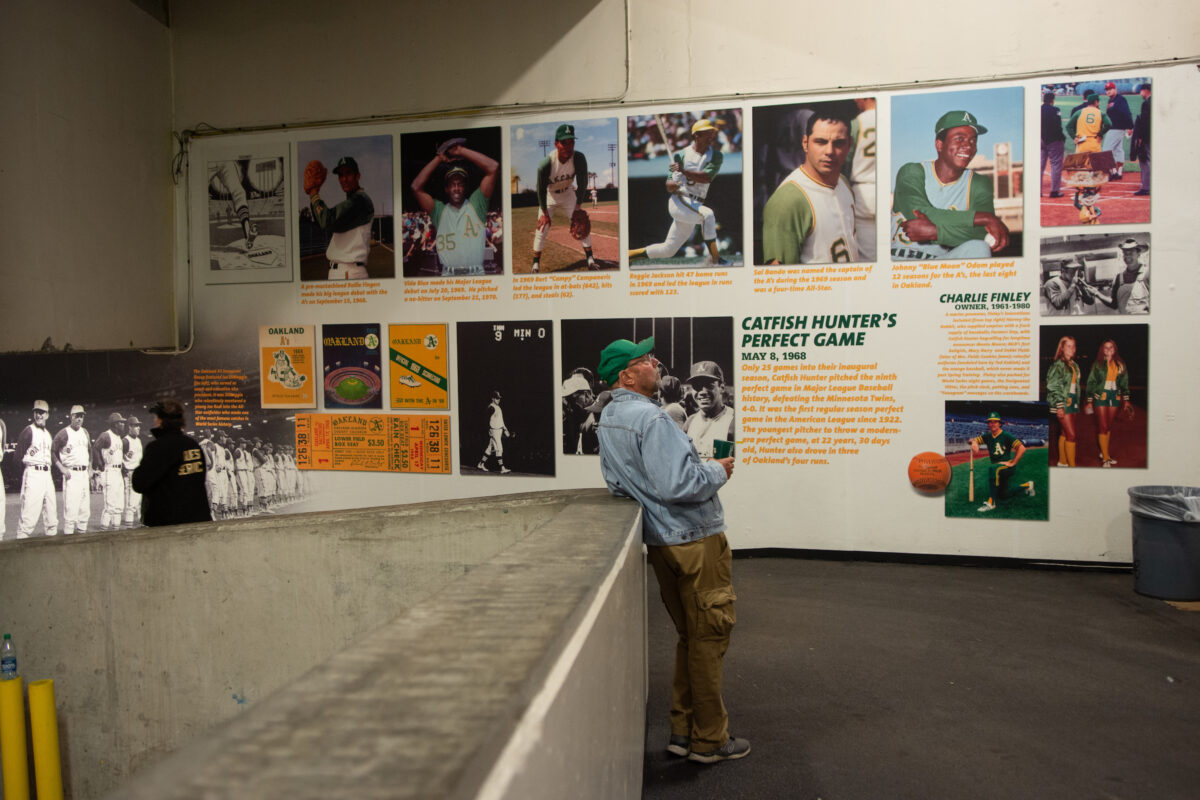


‘Sell the team’
In a cavernous stadium that seats 47,000 and can be expanded for up to 57,000 for special events, the chant of “sell the team,” echoes throughout the ballpark.
A nightly protest usually takes place at the top of the fifth inning with fans loudly advocating for the unlikely prospect that Fisher will sell the team to local buyers who will keep the franchise in Oakland.
SELL in capital letters is the single-word protest message on Kelly green T-shirts many of the fans wear at games. The idea for shirts was created by fans as part of a June 13 “reverse boycott” game that drew a then-season high of 27,759. Leaders of the reverse boycott movement have taken the protest to other ballparks, including Seattle during the All-Star Game and to Dodger Stadium in Los Angeles.
Two “reverse boycott” games took place Aug. 5-6 when the San Francisco Giants came to the Coliseum in what was dubbed the “Unite the Bay” series.
The games drew 37,553 fans on Saturday and 27,381 on Sunday. Through 60 home games, the A's have averaged more than 10,500 fans per game, roughly 22 percent of the Coliseum's capacity.
“You should have been here over the weekend. It was loud,” MacNeil said.
The weekend attendance was gratifying to Lori Buller of Redding, an A’s season ticket holder who has been sitting in the same seats 20 rows behind the A’s dugout since the 1970s.
“The weekend games showed there is love for this team in Oakland, despite what the owners will tell you,” Buller said. “This is personal. The owners have punched everyone in the gut. At one point, it looked like the team was staying, and the next thing you know, they were headed to Las Vegas.”
A few rows below Buller, Riley Miller, wearing a green SELL T-shirt, rallied the crowd in the third inning of the Monday game with his plastic stadium horn. The four quick foghorn-like sounds resonated throughout the nearly empty ballpark and were followed by the chants of “Let’s go Oak-Land!”
To Miller’s delight, the A’s scored three runs that inning.
“I do it for the kids,” said Miller, when asked why he brings along a stadium horn. “I used to be one of those kids at this stadium. Personally, I really love this old stadium.”
Miller would like the team to remain at a refurbished Coliseum.
“There are a lot of us who believe in this ballpark,” Miller said of the Coliseum where the A’s won four World Series titles, including three straight between 1972 and 1974 with a roster that include Hall of Fame members Reggie Jackson, Rollie Fingers and Jim “Catfish” Hunter.
“The A’s need to be in Oakland,” Miller said.
In addition to the World Series victories, the Oakland A’s became part of pop culture when the team’s 2002 season was detailed in the book “Moneyball” by Michael Lewis, which explored the work of general manager Billy Beane and his analytical approach to assembling a competitive roster despite the team’s small budget. That year, the A’s won 20 consecutive games and finished first in the American League West. The book was turned into a 2011 movie that starred Brad Pitt.
The team’s history, fans said, ties the franchise to Oakland.
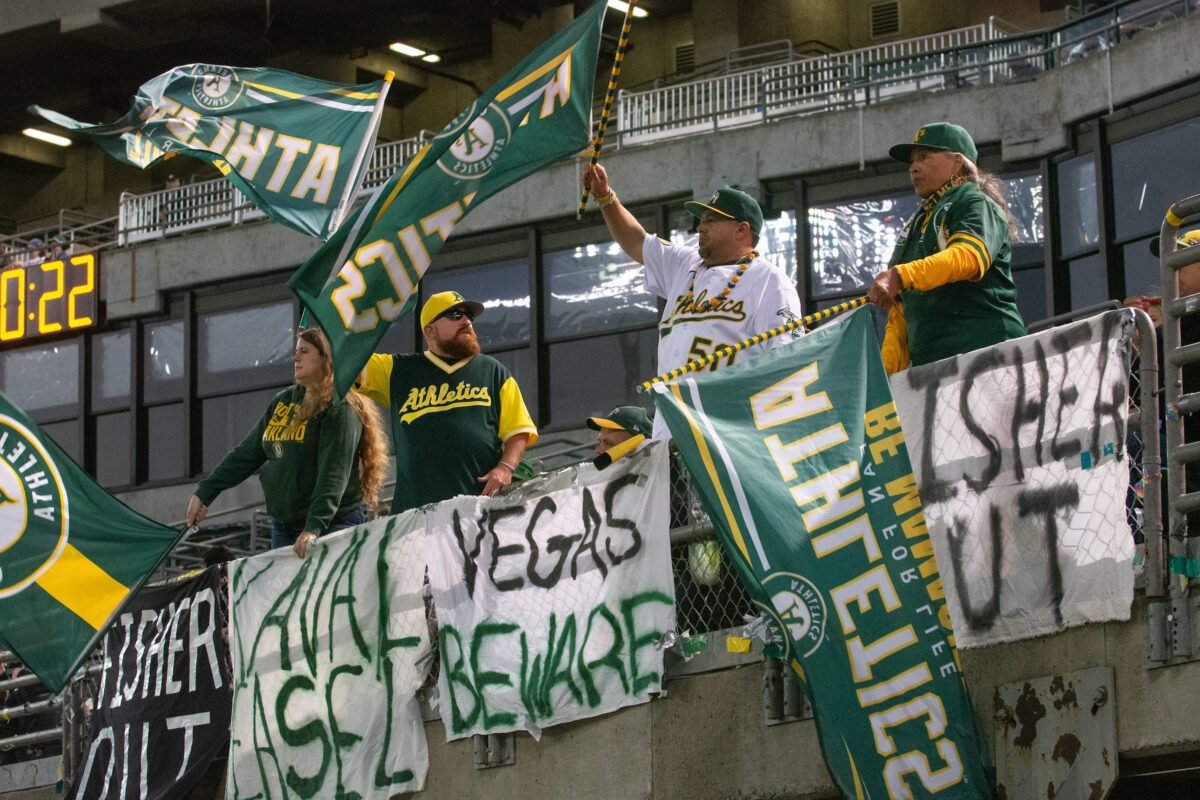
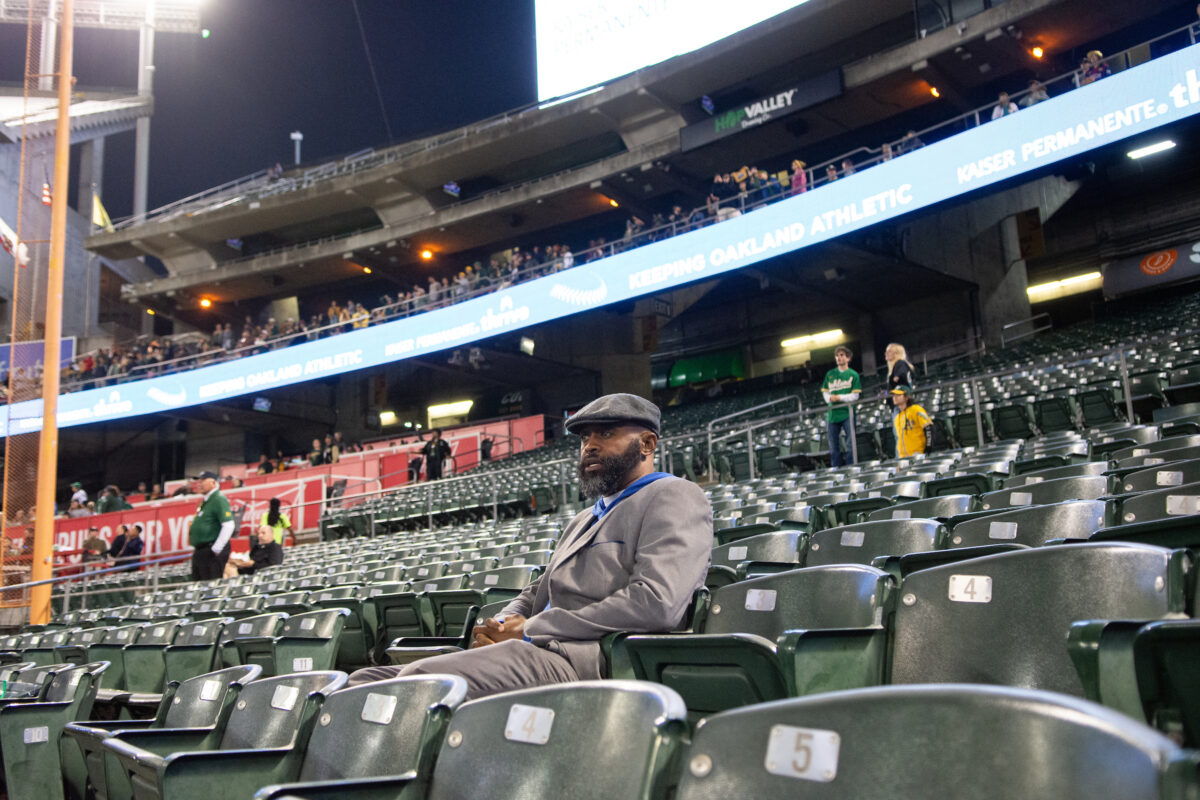
Visiting Vegas is out
The A’s spent nearly two years exploring potential sites in the Las Vegas area, while at the same time negotiating with Oakland over the waterfront site. In late April, the team announced it had a “binding agreement” to build a ballpark on nearly 49 acres just west of Interstate 15 near the Strip.
A month later, the team pulled out of that deal and signed a “binding agreement” for 9 acres on a 35-acre Las Vegas Strip location that houses the Tropicana Hotel and Casino. The A’s relocation, which still needs approval by Major League Baseball, may not take place until 2028 when the Las Vegas ballpark is expected to be completed.
Nevada lawmakers and Gov. Joe Lombardo approved $380 million in public financing for the proposed Las Vegas stadium in June.
The team is scheduled to play next season in Oakland with the following three seasons yet to be determined.
Unlike fans of the Oakland Raiders, who continued their allegiance when the franchise moved to Las Vegas in 2020 by buying season tickets at the $1.9 billion Allegiant Stadium, many A’s fans say they won’t make a special trip to watch the team on the Strip.
“I go to Vegas maybe four times a year for business,” said Feldman, a software salesman. “Maybe I would see a game if it were to coincide with one of my trips. I don’t think I would go out of my way.”
Rahsaan Lewis, 45, has been coming to A’s games since the 1970s. His seats along the right field line are behind the visiting team’s bullpen. The Coliseum and Tropicana Field in Tampa are the only major league ballparks where bullpens are located in foul territory and not behind outfield fences.
Lewis said he doesn’t care if the team moved to the waterfront ballpark or a renovated Coliseum. Vegas is out of the question.
“I will be fine if they go to [the waterfront site] and I would be fine if they stay [at the Coliseum],” Lewis said. “One hundred percent no, I won’t follow them to Las Vegas.”
Added Siebert, whose seats are near Lewis, “I’ll go to all other 29 [Major League Baseball] ballparks, but I won’t go to Las Vegas.”
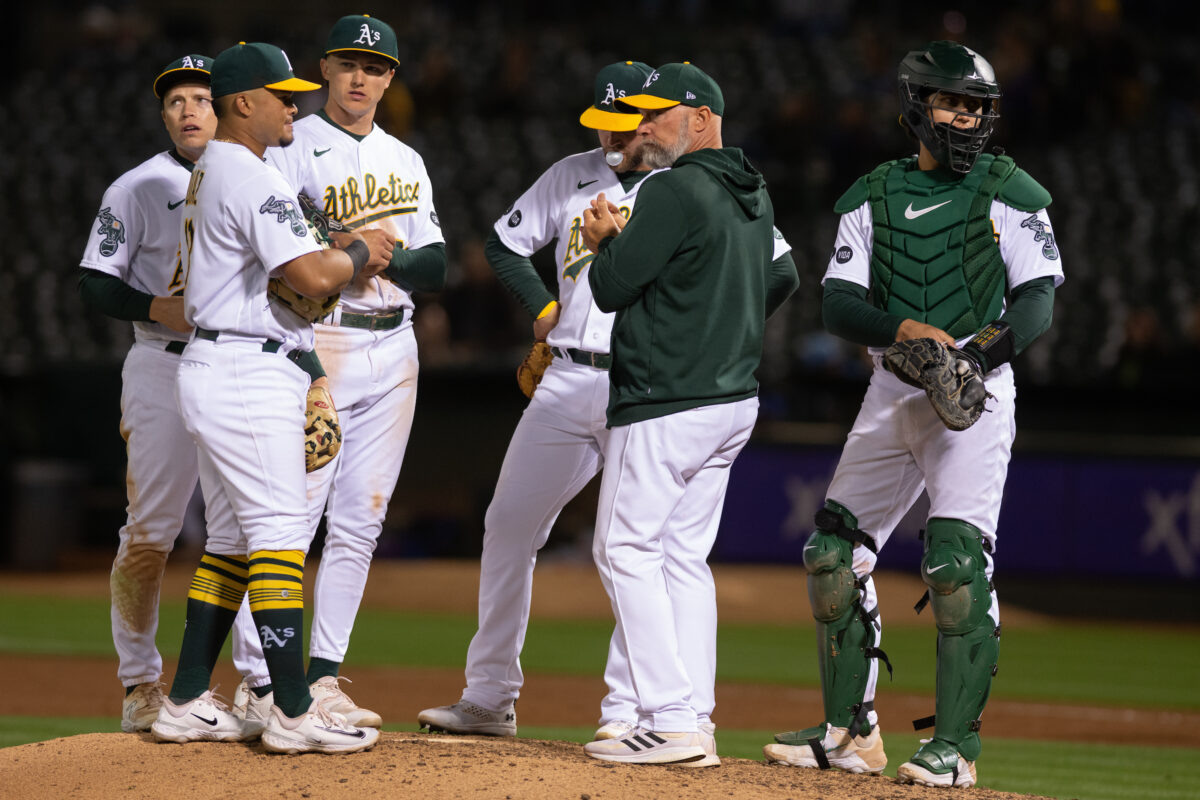
Ignoring the noise
A’s players and coaches hear the “sell the team” chants and see the empty ballpark.
A’s Manager Mark Kotsay said the players know about the potential Las Vegas relocation, but their job is to be prepared to play every day regardless of the team’s uncertain future.
“Anytime you're aware of something, you can either allow it to be a distraction, or you can focus on what's really important and what's in front of you,” Kotsay said. “As players, that's to prepare to play every day. You can't prepare for anything in your future in this game because things change every day.”
Kotsay, 47, speaks from experience. He played 1,914 major league games for seven teams including four seasons with the A’s. He was an A’s coach from 2016 through 2021 before being elevated to manager in 2022.
He said the message from the outset has been to “focus on what we have control over. Not what we don’t.”
The A’s have been connected to Las Vegas since 2019 when the Las Vegas Aviators became the team’s Triple-A affiliate. Much of the A’s current roster has played at the 10,000-seat Las Vegas Ballpark in Summerlin.
“Vegas is a great environment and it’s probably one of the better spots for Triple-A,” said infielder Nick Allen, who has been back and forth between Las Vegas and Oakland three times this season. “But you can’t really beat being in the big leagues.”
Allen hit two home runs for the A’s during the Sunday game against the Giants. His double to left field on Monday started a rally against Texas. He noticed the difference in crowd noise on Sunday, which had seven times more fans in the ballpark.
“The fans want us to stay here as much as we want to play here,” Allen said.


Catcher Shea Langeliers was traded to the A’s from the Atlanta Braves as part of a four-player package for all-star first baseman Matt Olson. He spent much of 2022 in Las Vegas before joining the A’s permanently. He earned post-season Pacific Coast League All-Star honors and was the most valuable player of the MLB Futures game.
He said any discussion about Las Vegas has been around the summer heat, which often hits triple digits at game time. Oakland’s climate is more temperate.
“I’m one of the guys who has got to experience both,” Langeliers said. “The thing that kind of sticks out to me the most is being a catcher and having to wear the gear all the time. Honestly, there is not a whole lot of discussion [about the relocation]. I think we're just trying to focus on our jobs.”
Outfielder Cody Thomas joined the A’s on July 7 and said there were never any talks about the A’s moving with teammates in the Las Vegas clubhouse. He was returned to the Aviators last week.
“I feel like there is a lot of love here for the A’s and you really saw it during the games with San Francisco,” Thomas said. “The crowds were awesome and the fans have been great.”
Thomas and infielder Jonah Bride, who joined the A’s for the third time this season on Aug. 3, noted one advantage for hitters in Las Vegas — the ball travels farther in the hot, dry air. In one of his last games before joining the A’s, Bride hit a home run in Las Vegas that cleared the Hanger Bar in right-centerfield, more than 400 feet from home plate.
“I enjoyed my time in Vegas,” Bride said. “You see the history in Oakland and the fans here have been great. You just try and keep your eyes between the lines.”

A Las Vegan weighs in
Not everyone thinks Las Vegas would be a terrible place for baseball.
Texas Rangers pitching coach Mike Maddux believes Las Vegas would be a good home for Major League Baseball. The Las Vegas native played for Rancho High School before embarking on a 15-year career with nine different major league teams. He is a member of the Southern Nevada Sports Hall of Fame.
Maddux didn’t comment specifically on the A’s. But he said a good indicator was the quick success of the NHL’s Vegas Golden Knights and the NFL’s Las Vegas Raiders. Pro sports, he said, draw locals and visitors.
“Why wouldn’t [Las Vegas] support a baseball team?” Maddux said. “It's a metropolitan area and people need an excuse to go to Vegas, so why not go there and route your cab to the ballpark?”
He said, “It was a tough call” if Las Vegas should bring in the A’s or wait for an expansion team.
“I think what the Golden Knights did [playing for the NHL championship in the team’s first season and winning the Stanley Cup in just six years] was so rare,” Maddux said. “But having a team already in place probably puts you a little bit ahead of the curve.”
As a longtime Las Vegan — who now lives in Texas — Maddux said the Tropicana site “was a pretty good setting” for the planned 33,000-seat stadium. “I hate to see the Tropicana go. It’s been such a fixture on the landscape.”
He mentioned the weather similarities between Las Vegas and Phoenix, where the Arizona Diamondbacks’ Chase Field has a retractable roof.
“Putting a roof on the ballpark would be a little more fair [for home and visiting teams],” Maddux said. “It gets pretty toasty in the summer in Vegas.”
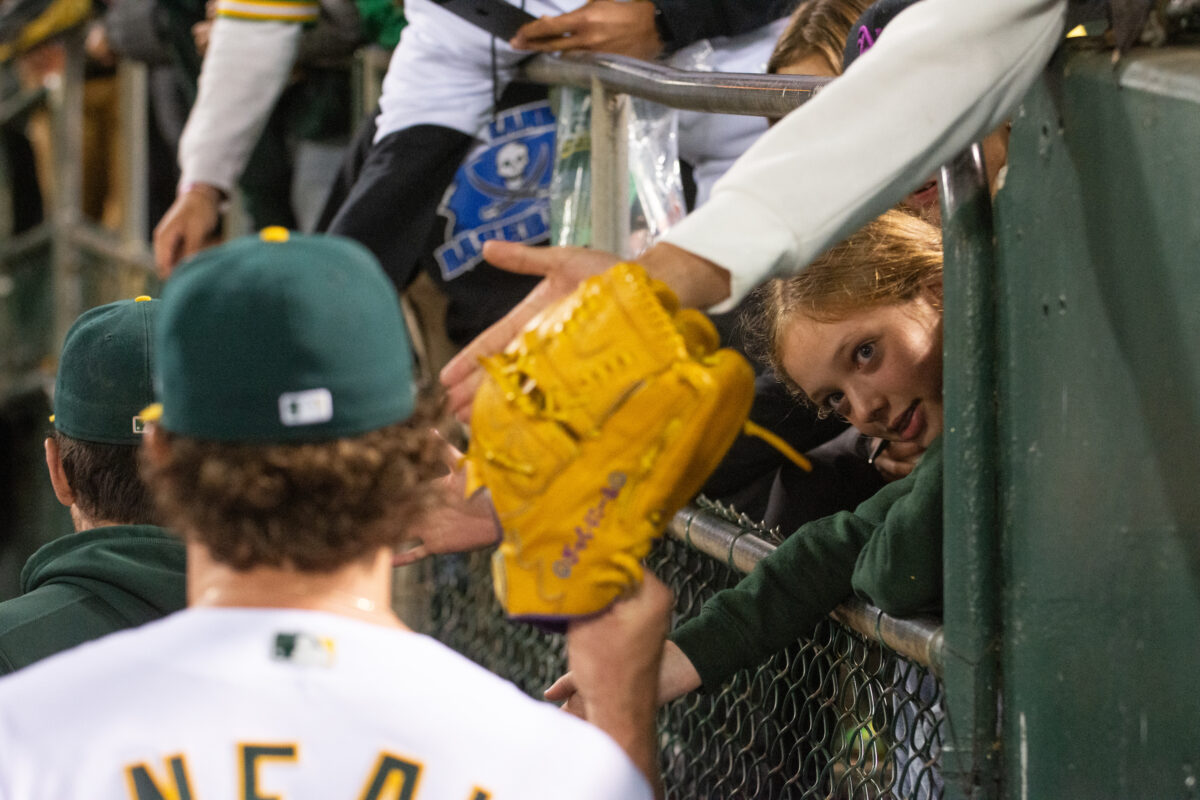
Bang the drum
Back in right field, A’s fans set up their drums before the game and keep a steady beat going for nine innings.
Oakland resident Esperanza Uruena called the drums a sign of support. She also hangs the Colombian flag for Jordan Diaz, an A’s infielder who is a native of Colombia. She has been coming to the Coliseum since 1988.
“Sell the team,” was the simple message she had for ownership.
Meanwhile, A’s outfielder Thomas, who often starts in right field, says he hears the beat of the drums loud and clear.
“You just focus on what you’re doing and end up blocking out a lot of it,” he said.
